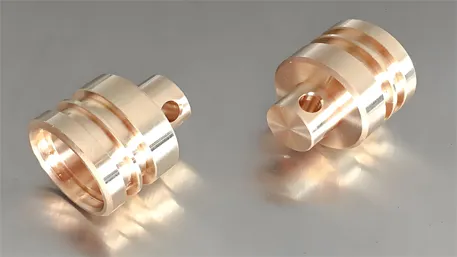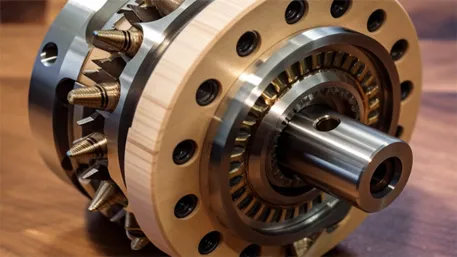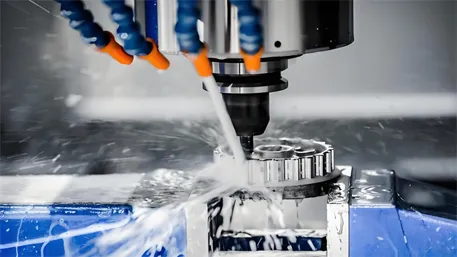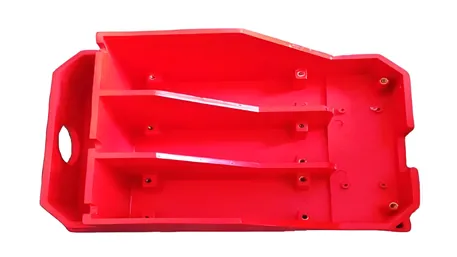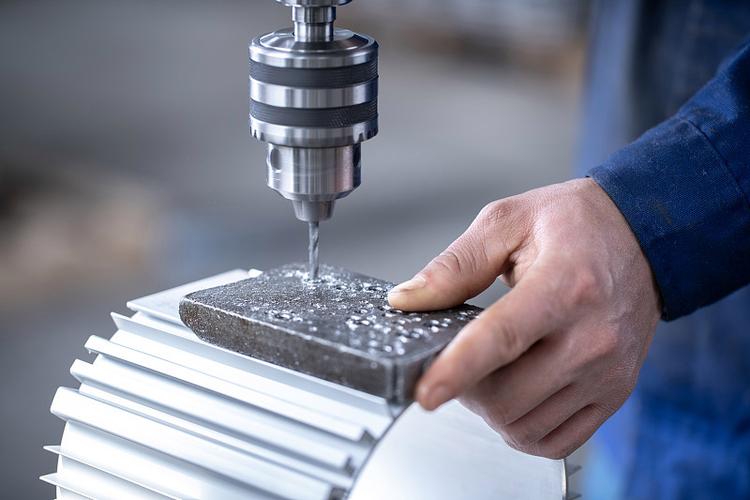
- CNC drilling accounts for ~35% of CNC machining operations (dominant in hole-making; Source: 2025 Global CNC Machining Application Report).
- CNC milling accounts for ~45% (dominant in contour machining; Source: CNC Milling Market Analysis 2025).
- 60% of mechanical parts (e.g., brackets with counterbored holes) require both processes to finish—drilling creates the base hole, milling adds the stepped contour.
2. Core Differences: Drilling vs. Milling (Side-by-Side Comparison)
|
Comparison Dimension
|
CNC Drilling
|
CNC Milling
|
|
Core Purpose
|
Create cylindrical holes (through/blind, standard sizes)
|
Shape complex contours (slots, pockets, arcs, 3D surfaces) + refine holes
|
|
Motion Logic
|
Tool rotates (spindle-driven); workpiece/tool moves linearly (X/Y/Z) to feed
|
Tool rotates (spindle-driven); tool moves in 2-5 axes (X/Y/Z/A/B) for contour
|
|
Tool Design
|
Single-point/dual-flute (e.g., twist drill: 2 flutes for chip evacuation)
|
Multi-flute (e.g., end mill: 2-10 flutes for smooth cutting)
|
|
Material Removal Method
|
Axial cutting (material removed along tool centerline)
|
Radial/axial cutting (material removed from tool side/end)
|
|
Precision Range
|
Position accuracy: ±0.005-0.01mm; Hole diameter tolerance: H7-H8
|
Position accuracy: ±0.002-0.005mm; Contour tolerance: ±0.001-0.003mm
|
|
Efficiency (Hole-Making)
|
Fast for standard holes (e.g., φ8mm hole: 2s/piece in aluminum)
|
Slow for hole-making (e.g., φ8mm hole: 15s/piece—needs circular interpolation)
|
|
Key G-Codes (FANUC)
|
Hole cycles: G81 (spot drilling), G83 (peck drilling), G82 (counterboring)
|
Contour codes: G01 (linear), G02/G03 (arc), G73 (peck milling)
|
3. Application Scenarios: When to Choose Drilling vs. Milling
A. Choose CNC Drilling When:
- You need standard cylindrical holes (diameter 0.1-100mm) in any material (steel, aluminum, PCB).
- Efficiency is critical (high-volume hole-making, e.g., 1000×φ5mm holes in automotive engine blocks).
- Hole depth is ≤5×diameter (standard twist drills) or ≤30×diameter (deep-hole drills with internal coolant).
- Drilling oil holes in transmission shafts (φ3mm×15mm blind holes).
- Drilling mounting holes in PCB boards (0.1mm micro-holes via dedicated drill centers).
B. Choose CNC Milling When:
- You need complex contours (slots, pockets, angled surfaces) or non-circular holes (e.g., square holes, elliptical holes).
- Hole precision requirements exceed drilling capabilities (e.g., hole position tolerance ±0.002mm for aerospace parts).
- You need to refine holes (e.g., counterbores, chamfers, or enlarging irregular holes).
- Milling a 6×6mm keyway in a φ25mm shaft (after drilling a φ5mm pilot hole).
- Milling a 3D curved surface on a turbine blade (5-axis milling).
- Milling a φ12mm counterbore on a φ8mm drilled hole (for bolt heads).
C. Synergistic Scenarios (Both Processes Required):
- Counterbored Holes: Drill φ8mm base hole → Mill φ12mm×3mm counterbore (for M8 bolts).
- Slotted Holes: Drill two φ5mm pilot holes → Mill a 5×20mm slot connecting them.
- Angled Holes: Drill a straight φ6mm hole → Mill the hole entrance to 45° (for pipe connections).
4. Key Technical Differences: Tools, Parameters & Cycles
A. Tool Selection: Drilling Tools vs. Milling Tools
|
Tool Category
|
CNC Drilling Tools
|
CNC Milling Tools
|
|
Common Types
|
Twist drill, spot drill, deep-hole drill, counterbore drill
|
End mill (flat/ball/nose), face mill, slot drill, chamfer mill
|
|
Flute Count
|
2 flutes (standard twist drill)
|
2-10 flutes (4 flutes for general milling, 10 for high-speed aluminum)
|
|
Material Focus
|
Carbide (for steel/aluminum), diamond-coated (for PCB micro-holes)
|
Carbide (most common), HSS (low-speed steel milling)
|
|
Key Feature
|
Pointed tip (centers itself in workpiece)
|
Flat/rounded tip (cuts side/end surfaces)
|
B. Cutting Parameter Optimization
|
Material
|
Process
|
Tool Type
|
Spindle Speed (S)
|
Feed Rate (F)
|
|
6061 Aluminum
|
Drilling
|
φ8mm Carbide Twist Drill
|
3000r/min
|
150mm/min
|
|
6061 Aluminum
|
Milling
|
φ8mm 4-Flute End Mill
|
4000r/min
|
200mm/min (linear)
|
|
45# Steel (HB200)
|
Drilling
|
φ8mm Carbide Twist Drill
|
1200r/min
|
50mm/min
|
|
45# Steel (HB200)
|
Milling
|
φ8mm 4-Flute End Mill
|
1500r/min
|
80mm/min (linear)
|
C. Critical Cycles: Drilling Cycles vs. Milling Cycles
|
Process
|
Core Cycles (FANUC)
|
Purpose
|
|
Drilling
|
G81 (spot drilling): Fast shallow holes
|
Creates 2-5mm deep guide holes (prevents drill wandering)
|
|
G83 (peck drilling): Deep holes
|
Evacuates chips for holes >5×diameter (e.g., φ5mm×30mm hole)
|
|
|
G82 (counterboring): Stepped holes
|
Adds shallow counterbores (limited to small diameters ≤20mm)
|
|
|
Milling
|
G02/G03 (arc interpolation): Circular contours
|
Mills counterbores, arcs, or non-circular holes (e.g., φ12mm counterbore)
|
|
G73 (peck milling): Deep slots
|
Evacuates chips for deep slots (e.g., 5×20mm×10mm deep slot)
|
|
|
G17/G18/G19 (plane selection): Multi-axis milling
|
Defines cutting plane (XY for flat milling, XZ for cylindrical milling)
|
5. Practical Case: Drill-Mill Synergy for a Counterbored Bracket
Step 1: Process Planning (Drill First, Mill Second)
- Spot Drilling: G81 creates 2mm-deep guide holes (avoids drill wandering).
- Final Drilling: G83 drills φ8mm×10mm through holes (peck drilling for chip evacuation).
- Counterbore Milling: G02 mills φ12mm×3mm counterbores (uses φ12mm 4-flute end mill).
Step 2: Equipment & Tools
- Machine: FANUC 0i-MF 3-axis milling center (supports both drilling and milling cycles).
- Tools: T01 (φ6mm spot drill), T02 (φ8mm carbide twist drill), T03 (φ12mm 4-flute flat end mill).
Step 3: Programming Snippet (FANUC System)
Step 4: Quality Verification
- Hole Size: φ8mm hole (pin gauge φ8H7 passes); φ12mm counterbore (calipers measure 12±0.005mm).
- Counterbore Depth: 3±0.01mm (depth gauge).
- Surface Roughness: Ra=1.2μm (bore scope inspection—meets requirement).
6. Common Misconceptions & Solutions
1. Misconception: “Milling can replace drilling for all holes.”
- Reality: Milling is inefficient for standard cylindrical holes—drilling is 5-10x faster. For example, drilling 100×φ8mm holes takes 3 minutes; milling the same holes takes 25 minutes.
- Solution: Use drilling for standard holes; reserve milling for non-circular holes or counterbores.
2. Misconception: “Drilling can create counterbores (no need for milling).”
- Reality: Drilling’s G82 cycle only handles small counterbores (≤20mm diameter, ≤5mm depth) with poor surface quality (Ra≥3.2μm). Milling creates larger, smoother counterbores (Ra≤1.6μm).
- Solution: For counterbores >φ20mm or depth >5mm, use milling (G02/G03) instead of G82.
3. Misconception: “Hole precision is the same for drilling and milling.”
- Reality: Milling achieves higher position accuracy (±0.002mm vs. drilling’s ±0.005mm) because it uses multi-axis interpolation and tool radius compensation.
- Solution: For precision holes (e.g., aerospace engine holes with ±0.003mm tolerance), mill the hole after drilling (or mill directly for small batches).
7. Q&A: High-Frequency Questions About Drilling vs. Milling
Q1: Can I use a milling end mill to drill holes (instead of a twist drill)?
- Yes, but it’s inefficient: A φ8mm end mill drills a hole 5x slower than a twist drill (needs G02 circular interpolation to “carve” the hole). Use this only if:
-
- The hole is non-circular (e.g., square) or has tight tolerance (±0.002mm).
-
- You don’t have a suitable twist drill (emergency only).
Q2: What’s the cost difference between drilling and milling?
- Drilling: Lower cost—twist drills ((5-)20 each) last 500-1000 holes; dedicated drill centers ((50k-)100k) have low maintenance.
- Milling: Higher cost—end mills ((15-)50 each) last 300-500 contours; 3-axis milling centers ((80k-)200k) need more frequent servo calibration.
- Synergy Tip: Use a milling center for small-batch “drill-mill” parts (avoids buying two machines); use dedicated drill centers + milling centers for high-volume production.
Q3: How to process a complex hole (e.g., φ8mm hole with a 45° angled slot)?
- Combine drilling, milling, and 5-axis movement:
-
- Drill φ8mm through hole (G83).
-
- Tilt the workpiece to 45° (5-axis A-axis).
-
- Mill the 45° slot (G01 linear interpolation) using a φ3mm end mill.

